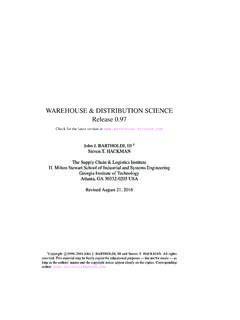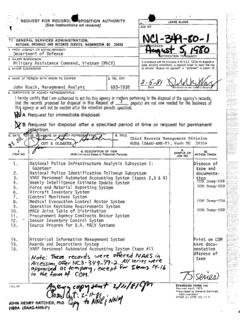Transcription of MOSAIC WARFARE - CSBA
1 MOSAIC WARFAREMOSAIC WARFAREEXPLOITING ARTIFICIAL INTELLIGENCE AND EXPLOITING ARTIFICIAL INTELLIGENCE AND AUTONOMOUS SYSTEMS TO IMPLEMENT AUTONOMOUS SYSTEMS TO IMPLEMENT DECISION-CENTRIC OPERATIONSDECISION-CENTRIC OPERATIONS BRYAN CLARK BRYAN CLARKDAN PATTDAN PATTHARRISON SCHRAMMHARRISON SCHRAMMMOSAIC WARFARE EXPLOITING ARTIFICIAL INTELLIGENCE AND AUTONOMOUS SYSTEMS TO IMPLEMENT DECISION-CENTRIC OPERATIONSBRYAN CLARKDAN PATTHARRISON SCHRAMM2020 The Center for Strategic and Budgetary Assessments is an independent, nonpartisan policy research institute established to promote innovative thinking and debate about national security strategy and investment options. CSBA s analysis focuses on key questions related to existing and emerging threats to national security, and its goal is to enable policymakers to make informed decisions on matters of strategy, security policy, and resource THE CENTER FOR STRATEGIC AND BUDGETARY ASSESSMENTS (CSBA) 2020 Center for Strategic and Budgetary Assessments.
2 All rights THE AUTHORSB ryan Clark is a Senior Fellow at the Center for Strategic and Budgetary Assessments. At CSBA he has led studies in naval WARFARE , electromagnetic WARFARE , precision strike, and air defense. In response to the 2016 National Defense Authorization Act, he led one of three navy fleet architec-ture studies that assessed the navy s future needs and the implications of new technologies for fleet design. Prior to joining CSBA, he was Special Assistant to the Chief of naval Operations (CNO) and Director of his Commander s Action Group, where he led development of navy strategy and implemented new initiatives in electromagnetic spectrum operations, undersea WARFARE , expe-ditionary operations, and personnel and readiness management. Mr. Clark was an enlisted and officer submariner, serving in afloat and ashore submarine operational and training assignments including tours as Chief Engineer and Operations Officer at the navy s nuclear power training unit.
3 He is the recipient of the Department of the navy Superior Service Medal and the Legion of Patt joined the Center for Strategic and Budgetary Assessments as a Non-resident Senior Fellow after serving at the Defense Advanced Research Projects Agency (DARPA) as the Deputy Director for the Strategic Technologies Office. He supported the Deputy Secretary of Defense in leading an effort to define a new modernization initiative for the Department of Defense. In this role, he advised the 2017 National Defense Strategy drafting group. He is also the Chief Executive Officer at a commercial robotics and artificial intelligence technology Schramm, CAP, PStat, is an Operations Research Professional working at the intersec-tion of Data, Models and Policy. In addition to his role as a Senior Fellow at CSBA, he is an active member of INFORMS and is General Chair of the 2020 INFORMS Conference on Security as well as a member of the Franz Edelman Prize Committee.
4 Mr. Schramm was a helicopter pilot and opera-tions research specialist, serving in squadrons based in the Norfolk, Guam, and Bahrain. He is a past recipient of the naval Helicopter Associations Aircrew of the Year, the Richard H. Barchi Prize, and notably the Clayton Thomas prize for contributions to the field of Operations study was sponsored by the Defense Advanced Research Products Agency (DARPA) sand would not have been possible without the guidance of John Paschkewitz and Samuel Earp of DARPA. The authors would like to also thank Kyle Libby, Peter Kouretsos, Lukas Autenried, Adam Lemon, and Grace Kim for their excellent work developing the MOSAIC WARFARE concept through wargames and workshops. Most importantly, the authors appreciate the excellent editing and production work of Kamilla Gunzinger. CSBA receives funding from a broad and diverse group of contributors, including private founda-tions, government agencies, and corporations.
5 A complete list of these organizations can be found on our website at : MOSAIC design by Harrison Schramm and Kamilla SUMMARY ..IThe Need for a New Warfighting Approach ..iiThe Shift to Decision-Centric WARFARE ..ivMosaic WARFARE ..viImplementing Decision-Centric WARFARE ..xTHE NEED FOR A NEW APPROACH TO WARFARE ..1 Today s Unsustainable Path ..6A Way Forward ..15A DECISION-CENTRIC APPROACH TO MILITARY OPERATIONS ..17 Combining Concepts with Technology ..17 Previous Competitive Regimes ..20 The Emerging Era of Decision-Centric WARFARE ..21 PURSUING DECISION SUPERIORITY THROUGH MOSAIC WARFARE ..27A More Composable Force Design ..27 Human Command and Machine Control ..35 Summary ..40 ASSESSING THE VALUE OF MOSAIC WARFARE ..41 Methodology ..42 Assumptions ..44 Wargame Results ..46 Summary ..54 IMPLEMENTING DECISION-CENTRIC WARFARE ..57 Adopting a New Strategy for Posture and Deterrence ..57 Developing Requirements to Enable Composability.
6 59 Conducting Idea-based Innovation ..60 Enabling Middle-Tier Acquisition ..60 Implementing Mission-based Budgeting ..61 Revising Doctrine and Training ..62 CONCLUSION ..63 LIST OF ACRONYMS ..65 FIGURESFIGURE 1: EXEMPLARY CONTEXT-CENTRIC C3 APPROACH ..VIIIFIGURE 2: RATIONALE BEHIND DECISION-CENTRIC WARFARE : OPERATIONAL AND INSTITUTIONAL IMPLICATIONS ..5 FIGURE 3: FEDERAL DISCRETIONARY AND MANDATORY FUNDING AND DEFICIT INTEREST AS A PERCENTAGE OF GDP ..9 FIGURE 4: MILITARY O&M COSTS PER SERVICE MEMBER ..10 FIGURE 5: TRENDS IN MILITARY END STRENGTH ..11 FIGURE 6: F-22 DEVELOPMENT VERSUS SIX GENERATIONS OF RUSSIAN DEFENSES ..13 FIGURE 7: MILITARY INNOVATIONS EMERGE FROM COMBINING SUSTAINING OR DISRUPTIVE TECHNOLOGIES WITH A NEW EVOLUTIONARY OR REVOLUTIONARY OPERATIONAL CONCEPT ..19 FIGURE 8: INNOVATIONS IN MODERN MILITARY HISTORY ..21 FIGURE 9: DIFFERING CONCEPTS OF THE INFORMATION ENVIRONMENT.
7 22 FIGURE 10: IMPOSING DILEMMAS USING A DECISION-CENTRIC APPROACH TO WARFARE ..23 FIGURE 11: IMPACT OF MOSAIC WARFARE ON THE O-O-D-A LOOP ..24 FIGURE 12: MONOLITHIC UNITS VERSUS COMPOSABLE FORCE PACKAGES ..28 FIGURE 13: EVOLUTION OF KILL CHAINS ..29 FIGURE 14: LIFETIME OF USEFUL ADVANCEMENTS IN SECOND WORLD WAR COMPETITIONS ..33 FIGURE 15: NOTIONAL C2 APPROACH ..36 FIGURE 16: THE COMPOSABILITY OF A DISAGGREGATED FORCE ENABLES A CONTEXT-CENTRIC C3 ARCHITECTURE ..39 FIGURE 17: METHODOLOGY USED FOR THE THREE CSBA-LED MOSAIC WARGAMES ..43 FIGURE 18: COMPLEXITY SCORE FOR WARGAME THREE BY TEAM ..48 FIGURE 19: INDEPENDENT ACTIONS CONDUCTED BY MOSAIC AND TRADITIONAL TEAMS IN WARGAMES TWO AND THREE ..49 FIGURE 20: TIME DELAY FOR PLANNING CELLS, TRADITIONAL VERSUS MOSAIC TEAMS ..50 FIGURE 21: OVERMATCH ACHIEVED BY MOSAIC AND TRADITIONAL FORCES AGAINST RED ..52 FIGURE 22: TRADITIONAL VERSUS MOSAIC FORCE LAYDOWNS.
8 53 FIGURE 23: TRADITIONAL VERSUS MOSAIC FORCE ATTRITION ..54 FIGURE 24: TRADITIONAL VERSUS MOSAIC FORCE COMPLEXITY AND SPEED ..55 FIGURE 25: REQUIREMENTS DEVELOPMENT APPROACH FOR DECISION-CENTRIC FORCES ..59 FIGURE 26: FROM DOMAIN-BASED COMPONENT COMMANDERS TO INTERDEPENDENT JTF COMMANDERS ..62 iExecutive SummaryThe United States is increasingly engaged in a long-term competition with the People s Republic of China (PRC) and the Russian Federation a competition in which defense leaders and experts argue the military is falling behind technologically and To regain its advantage, the Department of Defense (DoD)
9 Is pursuing new defense strategies and operational concepts designed to improve military capability by realigning defense posture and better integrating actions between air, land, sea, space, and cyberspace Implementation of these new approaches has led the government to increase DoD research and development (R&D) spending to levels not seen since the Second World War, accounting for Despite these efforts, the military may be unable to gain and maintain superiority over its great power competitors by simply using improved versions of today s forces to conduct modest variations on existing tactics. The capabilities DoD developed to help win the Cold War including stealth aircraft, precision weapons, and long-range communications networks have proliferated to other militaries. Potential adversaries have likewise observed operations during post-Cold War conflicts in Kosovo, Iraq, and Afghanistan and adapted their operational concepts As a result, military leaders acknowledge any future advantage forces gain under these circumstances may be narrow and Moreover, sustaining an advantage using only better versions of today s capabilities and tactics will be increasingly Paul Sonne and Shane Harris, Military Edge Has Eroded to A Dangerous Degree, Study for Congress Finds, The Washington Post, November 14, 2018.
10 2 Sydney J. Freedberg Jr., Services Debate Multi-Domain: Battle Or Operations , Breaking Defense, April 10, 2018. 3 David Vergun, DOD Leaders Make Case to Congress for Budget Request, DoD News Service, March 12, 2019, available at 4 David Ochmanek, RAND Corporation, Restoring the Power Projection Capabilities of the Armed Forces, testimony to the Senate Armed Services Committee, February 16, 2017, available at 5 John Richardson, A Design for Maintaining Maritime Superiority (Washington, DC: navy , 2018), p. 17, available at ii CSBA | MOSAIC WARFAREThe Need for a New Warfighting ApproachInstead of competing with other great powers using capabilities and operational concepts that have already proliferated to adversaries, the military should consider new approaches to WARFARE that could lead to a prolonged advantage. During the Cold War, for example, the United States was able to combine prominent emerging technologies with new operational concepts to overcome the numerical superiority of Soviet forces, first with nuclear weapons and later with precision weapons and Today, the most significant operational challenges facing forces include the long-range sensor and precision weapons networks fielded by the Chinese and Russian militaries.





